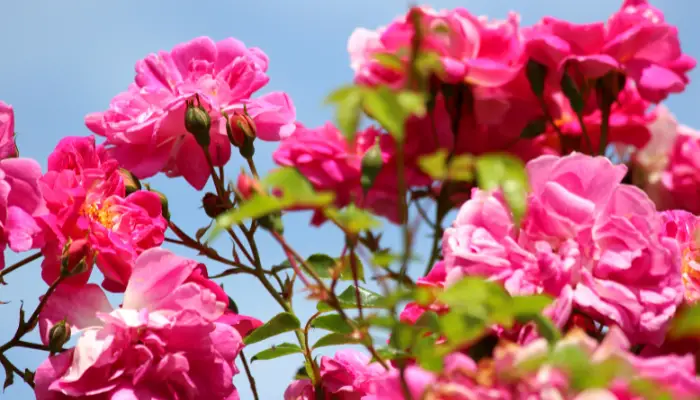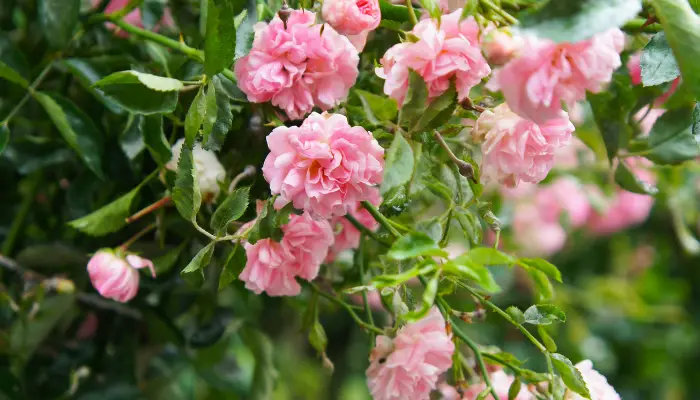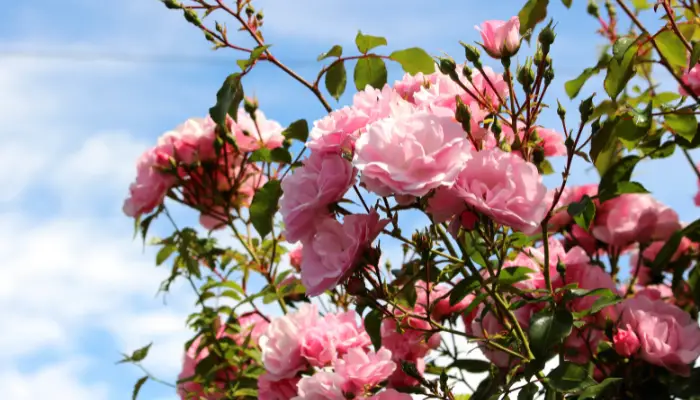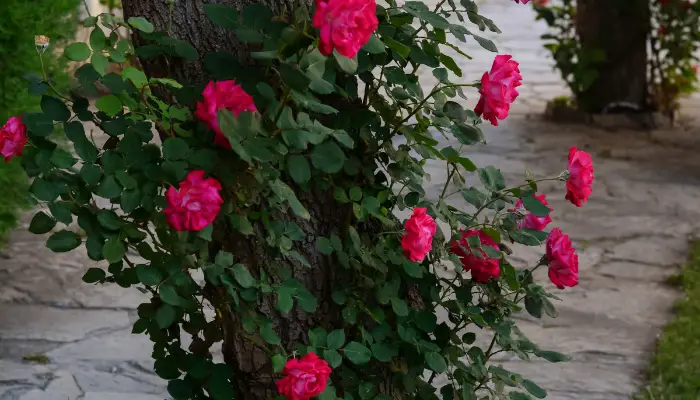Climber rose plants are not true climbers, meaning they do not have tendrils or suckers that can attach themselves to supports. Instead, they rely on gardeners to tie and train their stems to the desired shape and direction. Therefore, it is important to choose a suitable location and support for your climber rose plants before planting them.
The best location for climber rose plants is one that receives at least six hours of direct sunlight per day, preferably in the morning or evening. Avoid planting them in areas that are exposed to strong winds or frost, as these can damage the stems and flowers. Also, make sure the soil is well-drained, fertile, and slightly acidic, with a pH of 6.0 to 6.5. You can amend the soil with organic matter, such as compost or manure, to improve its texture and nutrient content.
The best support for climber rose plants is one that is sturdy, durable, and large enough to accommodate the growth of the plant. You can use trellises, arbors, pergolas, fences, walls, or even trees as supports, as long as they have horizontal or vertical bars or wires that you can tie the stems to. Avoid using supports that are made of metal, as they can conduct heat and burn the stems. Also, avoid using supports that are too close to the ground, as they can encourage fungal diseases and pests.
To plant climber rose plants, dig a hole that is twice as wide and deep as the root ball of the plant. Loosen the roots gently and spread them evenly in the hole. Fill the hole with soil, making sure the graft union (the swollen part where the stem meets the roots) is slightly above the soil level. Water the plant thoroughly and add a layer of mulch around the base to conserve moisture and prevent weeds.
Popular Varieties of Climber Rose Plants?

How to Grow Climber Rose Plants
There are many varieties of climber rose plants, each with different characteristics such as color, fragrance, size, and flowering habit. Some of the popular ones are:
- Altissimo: a floribunda rose with bright red single flowers and yellow stamens. It is disease-resistant and long-blooming
- American Beauty: a hybrid tea rose with dark pink cupped flowers and a sweet scent. It is hardy and tolerates shade
- Cécile Brunner: a hybrid tea rose with blush-pink clusters of small flowers and a spicy, tea-like fragrance. It is an heirloom rose that blooms once in late spring or early summer
- Claire Austin: a David Austin rose with creamy-white flowers and a strong myrrh scent. It is vigorous and repeat-flowering
- Parkdirektor Riggers: a hybrid tea rose with intense red semi-double flowers and little fragrance. It is tolerant of shade and repeat-flowering
- Pippin: a floribunda rose with warm pink double flowers and a sweet fragrance. It is repeat-flowering and ideal for growing near seating areas
- New Dawn: a large-flowered climber with soft pink semi-double to double flowers and a free-blooming habit. It is hardy in zones 5 to 9
- Golden Showers: a large-flowered climber with yellow flowers that open flat. It is hardy in zones 5 to 9
How to Choose the Right Climber Rose Plant For Your Garden?
Choosing the right climber rose plant for your garden depends on several factors, such as the color, fragrance, size, and blooming season of the roses, as well as the planting site, support, and maintenance requirements. Here are some general tips to help you make a good choice:
- Consider the color of the roses and how they will match or contrast with the rest of your garden. Climbing roses come in a wide range of colors, from white to yellow, pink, red, and even purple. You can also mix and match different varieties to create a colorful display.
- Think about the fragrance of the roses and how it will affect your enjoyment of the garden. Some roses have a strong and sweet scent, while others have a subtle or spicy aroma. You can also choose roses that have no fragrance at all, if you prefer.
- Choose a climber rose that will grow to the right size for the space you want to fill, both in terms of height and width. Check the label or the online description of the rose to see how tall and wide it will grow. Some roses are short and compact, while others are tall and vigorous.
- Decide when you want your roses to bloom and for how long. Climbing roses can be divided into three main groups: climbers, ramblers, and pillars. Climbers are repeat-flowering roses that bloom throughout the summer and sometimes into autumn. Ramblers are once-flowering roses that bloom in late spring or early summer and produce large clusters of small flowers. Pillars are roses that grow upright and produce large flowers at the end of long stems.
- Select a planting site that will provide the best conditions for your roses. Most climbing roses need at least six hours of direct sunlight per day, preferably in the morning or evening. They also need well-drained, fertile, and slightly acidic soil, with a pH of 6.0 to 6.5. You can amend the soil with organic matter, such as compost or manure, to improve its texture and nutrient content.
- Choose a support that will suit the growth habit and shape of your roses. You can use trellises, arbors, pergolas, fences, walls, or even trees as supports, as long as they have horizontal or vertical bars or wires that you can tie the stems to. Avoid using supports that are made of metal, as they can conduct heat and burn the stems. Also, avoid using supports that are too close to the ground, as they can encourage fungal diseases and pests.
How to Train Climber Roses on a Trellis?

Training your climber roses on a trellis is a great way to create a beautiful and fragrant display in your garden. Here are some basic steps to follow:
- Choose a sturdy trellis that can support the weight and size of your roses. The trellis should be at least 3 inches away from a wall or fence, and in a sunny and well-drained location
- Plant your roses about 18 inches away from the trellis, and angle them slightly towards it. This will help them grow towards the support and cover it more evenly
- Tie the stems of the roses to the trellis with a soft and stretchy material, such as pantyhose or plastic plant tape. Do not use wire or string, as they can cut into the stems and damage the plant.
- Train the roses to grow horizontally or diagonally across the trellis, rather than vertically. This will encourage more lateral branches and flowers to form along the stems. Gently bend and tie the stems to the trellis as they grow, and avoid twisting or breaking them.
- Prune your roses in early spring, before they start to grow new leaves and buds. Remove any dead, diseased, or damaged stems, as well as any that cross or rub against each other. Cut back any old or woody stems to make room for new and vigorous ones.
- Water and feed your roses regularly, especially during the blooming season. Apply a balanced fertilizer, such as 10-10-10, in spring and summer, following the label instructions. You can also add organic fertilizers, such as compost or manure, to enrich the soil and boost the flower production.
How to Care for Climber Rose Plants

Climber rose plants require regular watering, feeding, and pest and disease control to thrive and bloom. Water them deeply and infrequently, about once or twice a week, depending on the weather and soil conditions. Avoid wetting the foliage, as this can increase the risk of fungal infections. Feed them with a balanced fertilizer, such as 10-10-10, in spring and summer, following the label instructions. You can also add organic fertilizers, such as fish emulsion or bone meal, to boost the flower production and fragrance.
Climber rose plants are susceptible to various pests and diseases, such as aphids, spider mites, black spot, powdery mildew, and rust. To prevent and treat these problems, inspect the plants regularly and remove any damaged or diseased parts. You can also spray the plants with a homemade solution of water, baking soda, and dish soap, or use a commercial product that is safe for roses. Always follow the label directions and apply the spray in the early morning or evening, when the sun is not too strong.
How to Prune Climber Rose Plants
Pruning climber rose plants is essential to maintain their shape, health, and flowering. Pruning also helps to train the stems to grow in the desired direction and create a more attractive display. The best time to prune climber rose plants is in late winter or early spring, before the new growth begins.
There are two types of stems on climber rose plants: main stems and lateral stems. Main stems are the ones that grow from the base of the plant and form the framework of the support. Lateral stems are the ones that grow from the main stems and produce the flowers. The main stems should be pruned lightly, only to remove dead, damaged, or diseased wood. The lateral stems should be pruned more heavily, cutting them back to two or three buds from the main stems. This will encourage new growth and more flowers.
When pruning climber rose plants, use sharp and clean tools, such as pruning shears or loppers. Make clean and angled cuts, about 1/4 inch above a bud or a branch. Dispose of the pruned material properly and avoid leaving it on the ground, as it can harbor pests and diseases. After pruning, water and feed the plants to help them recover and grow.
Conclusion
Climber rose plants are a wonderful addition to any garden, as they can create a stunning vertical accent with their colorful and fragrant flowers. By following these tips on how to grow, care for, and prune climber rose plants, you can enjoy their beauty and charm for many years. For more information on climber rose plants, you can check out these sources:




